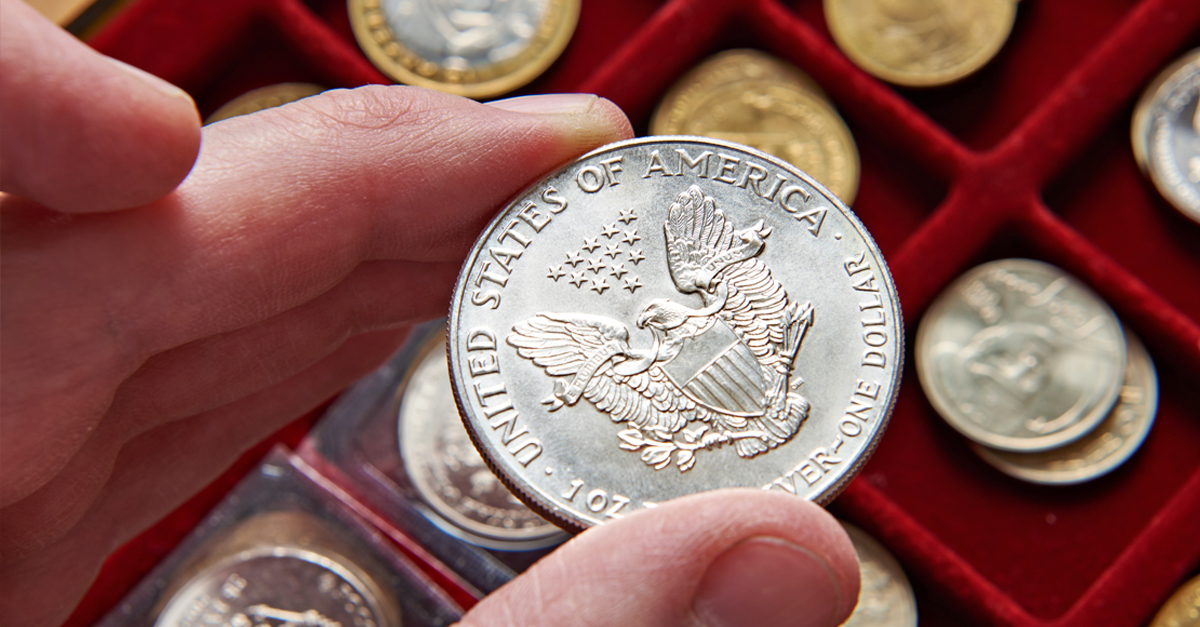Knowledge is power. And just like the native tongue is used in a country, coin terminology, coin-speak so to say, is used by coin collectors. Understanding and using the lingo of coins will give you a leg up as a buyer and seller—and more enjoyment too.
Listed here in alphabetical order are some of the most widely recognized terms used by coin collectors. Learn them; use them; and you’ll be another step further from potential swindler’s mark and closer to being an informed amateur collector—a better thing to be!
Bag mark: a highly visible scratch or gouge on a coin that most likely got there when the coin was hit by another coin during transport in a sealed bag from the mint.
Bourse: the area at a coin show or convention where dealers display their wares, primarily rare coins.
Bullion: metals such as silver or gold valued by their weight.
Business strike: a coin manufactured by the mint for people to spend in commerce.
Cameo: the visible contrast between a coin with frosted devices (the part that stands out, such as the lettering and portrait) and mirror-like fields (the flat background).
Certified coin: a coin submitted to an independent grading service such as the Numismatic Guaranty Corporation (NGC) or Professional Coin Grading Service (PCGS) that is rated on a one through 70 scale (one is the lowest grade; 70 is perfect) and encapsulated in a hard plastic holder that assures it is genuine.
Circulated: a coin passed from hand to hand that displays friction or wear.
Counterfeit: an inauthentic or fake coin.
Devices: the parts of a coin’s design that protrude such as the date and portrait.
Dies: the two metal pieces with engraved mirror-image coin designs that are used by the mint to stamp coins on metal disks.
Doctoring: any deceptive process (e.g. movement of metal, substance addition, chemical treatment) that changes the appearance of a coin, often to fool a grading service, to make it appear better than it is.
Face value: the spending value of a coin in commerce. For example, you can spend a quarter dollar for twenty-five cents.
Fields: the flat parts of a coin’s design that serve as the background.
Grade: the widely-understood nomenclature used to describe the condition of a coin. Adjectives—such as “gem” or “choice”—may be used…and coins are rated on a scale of one through 70, where a coin graded one is so worn that it is barely identifiable.
Hairlines: largely parallel but crisscrossing striations that are undeniable evidence of a coin having been abrasively cleaned, which lowers the coin’s grade and value.
Luster: the quality of light reflection on a coin’s surface (usually used in reference to Mint State coins). In manufacturing, coins are made with many tiny lines that contribute to the quality of light reflection. Think of looking at a Mint State coin under a lamp as looking at an ocean on a sunny day: From any angle, light will be reflected, but not in exactly the same way from any two angles.
Melt value: the value of a coin based on its metals composition or what you could get if you melted the coin for its metal.
Mint-mark: A letter, letters or other mark struck into a coin indicating at which mint it was manufactured. In the US, the Mint-marks are D for Denver and, on pre-1862 coins, for Dahlonega (Georgia); C for Charlotte; CC for Carson City; O for New Orleans; P for Philadelphia; S for San Francisco; and W for West Point. The absence of a Mint-mark indicates Philadelphia or West Point.
Mint State: the condition or grade of a coin that has not circulated and, thus, exhibits no wear.
Overgraded: a coin described as being in a higher grade than it actually is in.
Proof coinage: coins manufactured with a process that creates a special finish that are sold to collectors to save. Proof is not a grade, and proof coins are graded on the same one through 70 scale as non-proof coins.
Toning: the slow and natural process by which a coin reacts with its environment and turns colors. Toning is usually caused by moisture, a catalyst, reacting with sulfur or oxygen on the coin’s surface. Natural toning that took decades to develop can elevate a coin’s value substantially—and abrasively removing natural toning from a coin can destroy its value.
Check out Scott’s website, or purchase his latest book, The Coin Collector’s Survival Manual.


